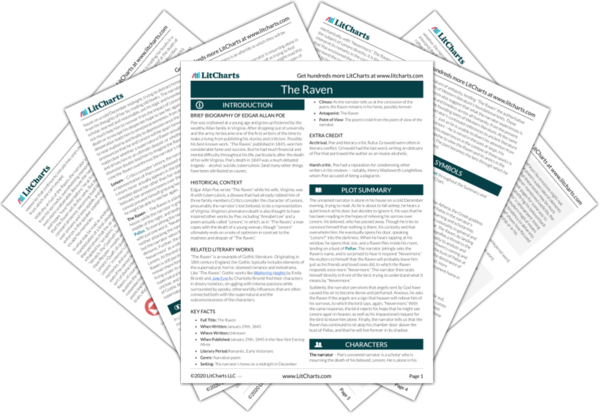“The Raven” is an example of Gothic literature, a genre that originated in 18th century England. Hallmarks of Gothic works include horror, death, the supernatural, and occasionally romance. Their characters are often highly emotional and secluded from society, living in dark, gloomy, medieval-like homes surrounded by wild natural landscapes. (“Gothic” refers to the architectural style of the residences in which these novels are set.) “The Raven” contains many elements that point to the narrative’s Gothic nature: a lonely character in a state of deep emotion, the cold and dark of a midnight in December. The Raven itself, a seemingly demonic, talking bird that arrives at midnight, is the poem’s most prominent example of the supernatural.
Gothic works — Frankenstein, Jane Eyre, and Wuthering Heights, to name a few — tend to make ambiguous whether the supernatural events they describe are actually happening, or if these events are a product of their characters’ subconscious. “The Raven,” by leaving unresolved the question of whether the Raven is the genuine presence of a supernatural force or a figment of the tortured narrator’s imagination, fits squarely into this tradition.
At the start of the poem, the narrator is reading his books in a failed attempt to distract himself from his grief at the death of his beloved Lenore, and is drowsing off. He then describes himself as having been roused by a mysterious tapping at his door and senses the presence of his dead love Lenore, followed by the arrival of the Raven through the window. Perhaps the Raven truly has arrived, but the narrator’s exhaustion leaves open the possibility that he has actually fallen more deeply asleep, and that the knock he hears signals the beginning of his entrance into a dream state. The Raven and its repeated message of “nevermore” may be a supernatural visitation, or an expression of the narrator’s loss and doubts, a nightmare from which the narrator can never fully awaken.
Ultimately, the poem does not take sides on whether its events should be interpreted as either entirely supernatural or entirely a result of the subconscious. In fact, the way it straddles and ties together the subconscious and supernatural helps to give the poem much of its power, depicting someone forced to confront the uncertainty, unknowability, and despair of losing a loved one, and having to face the profound and unanswerable question of death.
The Supernatural and the Subconscious ThemeTracker

The Supernatural and the Subconscious Quotes in The Raven
Over many a quaint and curious volume of forgotten lore…

Unlock explanations and citation info for this and every other The Raven quote.
Plus so much more...
Get LitCharts A+And the only word there spoken was the whispered word, “Lenore?”
This I whispered, and an echo murmured back the word, “Lenore!”
Tell me what thy lordly name is on the Night’s Plutonian shore!
“Doubtless,” said I, “what it utters is its only stock and store”…
Then, upon the velvet sinking, I betook myself to linking
Fancy unto fancy…
Then, methought, the air grew denser, perfumed from an unseen censer
Swung by Seraphim whose foot-falls tinkled on the tufted floor…
“Quaff, oh quaff this kind nepenthe and forget this lost Lenore!”
And the Raven, never flitting, still is sitting, still is sitting
On the pallid bust of Pallas just above my chamber door…











